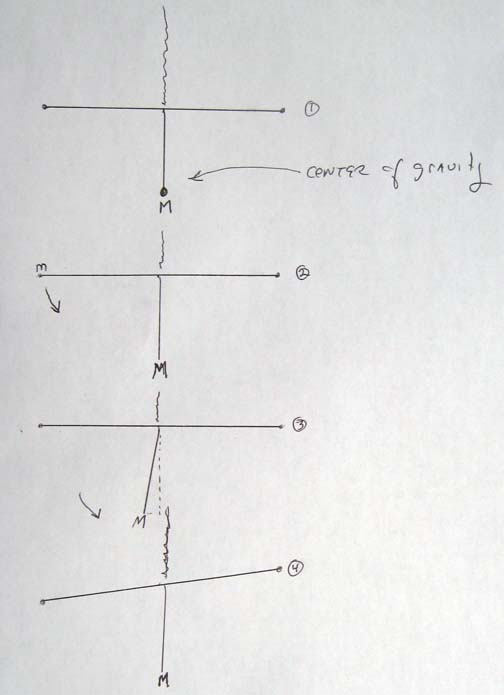Static Wind Turbine Blade Balancing
The rotor must be perfectly balanced or else vibration at high speeds can destroy the rotor. Balancing the wind turbine blades takes some patience. I would like to explain some basic theory so you have an understanding of how the balancing works. Without a good understanding, it is difficult to correctly balance the blades.
There are a few ways to balance a rotating object. Static balancing involves balancing a stationary object, while dynamic balancing works with the object during rotation. The latter requires some expensive machinary. With regards to the former there are two ways that come to mind. One method involves suspending the object on a horizontal pivot and letting the object settle. You will then add weights so the object does not settle to any dependent position because the center of gravity will be in the dead center. The second method involves suspending the object from a vertical wire and adding weights so the object rests perfectly horizontal. This is the method I will discuss.
If one takes a yard-stick and suspends it with a piece of string at the center it should balance. If you add a small weight to one end it will completely tip over; and, unless you perfectly match a weight on the other end, it is difficult to get the stick to remain level. This is because the center of gravity is in-line with the stick. When a weight is then added to the end, the center of gravity drasticly moves to that end. Systems want to seek their lowest energy level. In this case, gravity causes the center of gravity to seek the lowest point.
Look at this picture. Imagine the stick's weight is perfectly distributed. The center of gravity, M, is in the center. If a small weight, m, is added, the center of gravity is now at the left. The scale will tip 90 degrees counter-clockwise. This is not much of a scale. If the rotor's center of gravity is close to the wire, or above the wire suspending it, the system will become unstable and topple. You will have a hard time adding weights to get it level, because anything other than perfection results in the rotor tipping on its side. You will frustrate yourself to no end because the rotor will never get close to level.

Now let's look at the next image. A wire is connected to the center of the stick, forming a pivot point. Here, the center of gravity, M, is below the pivot point. If we add a small weight on the left, the resultant center of gravity is tilted slightly clockwise seen in 3. The degree of this tilt is the vector sum of the momement arms of m and M. The tilted center of gravity wants to cause the stick to rotates counter-clockwise until M is at the lowest point seen in 4. The stick does not tip over, but sags. Now we can slowly add weight to the right side allowing us to balance the stick.

If the center of gravity of our rotor is below the pivot point of our suspension line we can add weights to the elevated sides in order to balance the rotor. The weight multiplied by the distance from the center is the moment arm. A 10 gram weight 100 centimeters from the center is the same as 100 grams 10 centimeters from the center. Please note, that the string suspending the rotor must be perfectly centered.
I take a yard stick and measure where the blade tip rests. I then rotate the rotor and see where the next tip rests. All the tips should rest at the same height above the ground. I use the same location, rotating the rotor, to eliminate discrepancies with the height of the floor. If one tip is too high I add some weight to get it to match one of the tips. Then, if the other tip is too high or low, I add some weight to it, or to the other two blades, to get all three to match.
Since I used epoxy paint I was able to add some coats to the blades to add the weight I needed. If necessary, I sanded some paint off to reduce the weight. However, adding steel washers or lead weights at the bolts will also work.